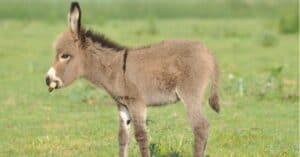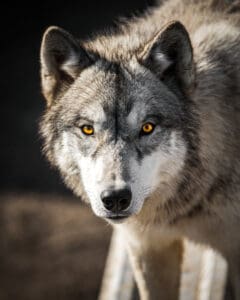Jackal vs Coyote: Key Differences & Who Would Win in a Fight?
@media (min-width: 481px) {
.mobile-top-content {
display: none;
}
}
#mobileTopContentCTACarouselControls { overflow: hidden; text-overflow: ellipsis; white-space: nowrap; }
.mobile-top-content .more { color: #fff; }
.mobile-top-content a { color: #fff; text-decoration: underline; }
.mobile-top-content a:hover { color: #fff; text-decoration: underline; }
@media (max-width: 480px) {
.mobile-top-content {
background-color: #06a10b;
color: #fff;
text-align: center;
/*height: 60px;
padding-top:5px;*/
font-size:80%;
/* display: block; */
margin: 0px -30px;
}
}
Although they may look similar jackals and coyotes are actually two different animals, and they come from different parts of the world. Jackals primarily live in Africa and Asia. Coyotes live in parts of North America and Central America. What would happen if these two canine animals met and fought? We’re going to take a look at a hypothetical jackal vs coyote fight. Discover which of these diminutive dogs has what it takes to win this battle!
Comparing a Jackal and a Coyote
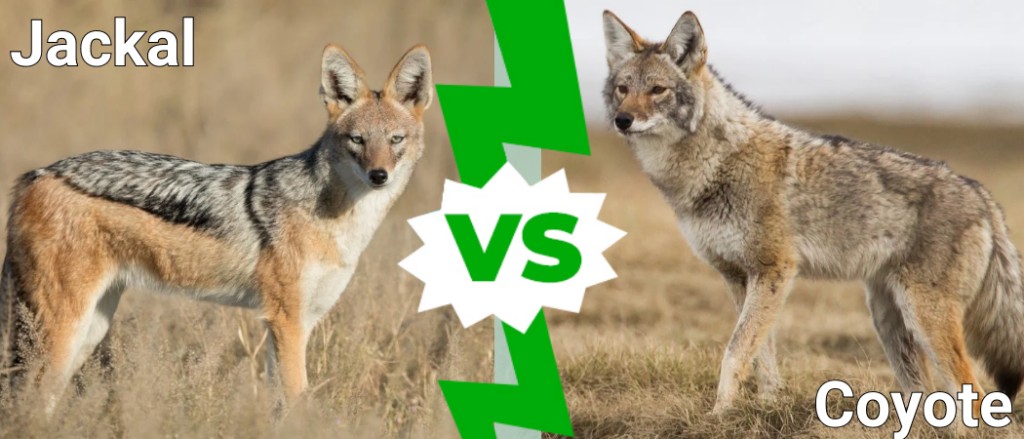
A-Z-Animals.com
| Jackal | Coyote | |
| Size | Weight: 11lbs – 26lbs Height: 16in Length: 24in – 30in |
Weight: 15lbs – 45lbs Height: 24in – 26in at the shoulder Length: 30in – 35in |
| Speed and Movement Type | 40 mph | 35-40 mph |
| Bite Power and Teeth | 94 Bite Force Quotient (BFQ) – 42 teeth – 1-inch, curved canines – They used their teeth to grab and then shake their prey. |
88 Bite Force Quotient (BFQ) 681 N bite power – 42 teeth 1.5-inch-long canines – Teeth used to grip and tear enemies. |
| Senses | – Better sense of smell than domestic dogs and wolves – Great sense of vision at night – Very acute hearing that helps them find prey in underground burrows |
– Great vision, including low-light and peripheral vision. – Sense of smell is similar to dogs – Good sense of hearing that allows them to hear up to a quarter of a mile |
| Defenses | – Speed – Their amazing senses |
– Speed – Senses help it avoid trouble |
| Offensive Capabilities | – Use their teeth to deliver a fatal bite to the back of the head and shake enemies | – Strong bite that helps them latch onto enemies and bring them to the ground. – May use sharp claws as a secondary form of offense |
| Predatory Behavior | – Can hunt or scavenge as part of a small group or alone – Opportunistic predator and persistence hunter – May eat carrion |
– Ambush predator when hunting alone – Hunt in packs for large prey using persistence predation |
What Are Key Differences Between a Jackal and a Coyote?
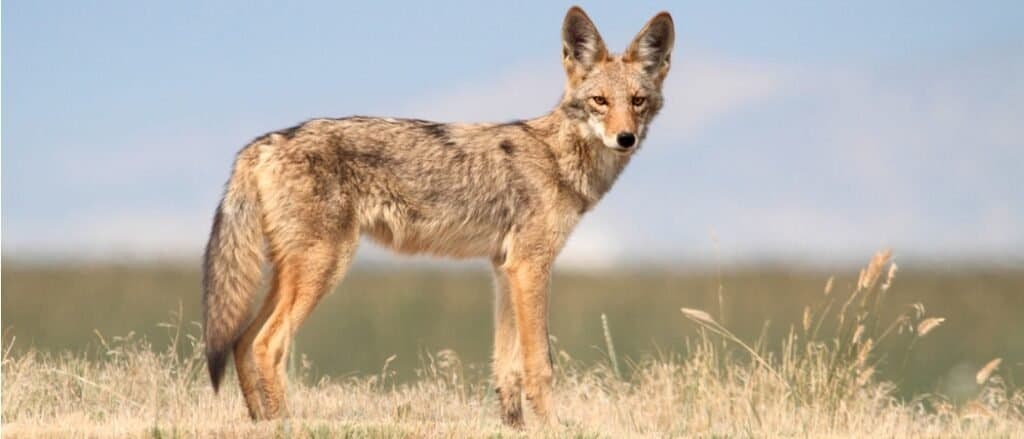
iStock.com/SteveByland
Jackals live in Africa and coyotes live in North America and Central America. Coyotes are larger than jackals, but they have a slightly weaker bite force. Coyotes have the scientific name Canis latrans and jackals are named Canis aureus.
Jackals will live alone, in pairs or packs. Coyotes are typically pack animals and they have a rigid social hierarchy. These are the most significant differences between these animals. Even though many of their features are similar, they are distinct animals.
The Key Factors in a Fight Between a Jackal and a Coyote
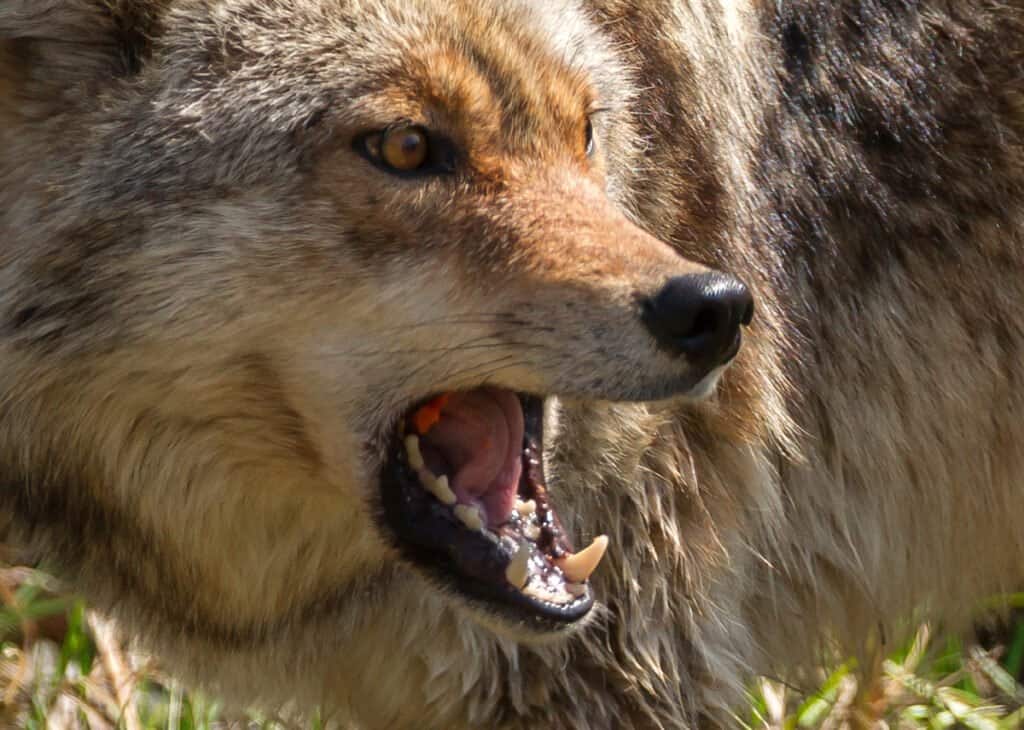
Derek R. Audette/Shutterstock.com
How are we going to say which of the two creatures is the most likely to succeed in a battle when they live half a world away? Determining the winner of the fight is going to require some guesswork based on hard evidence.
In this case, we’re going to look at key factors including physical features of the coyote and jackal along with how the two battle their foes. By doing this, we’ll gain enough insight to say which of them is stronger, faster, and deadlier in a fight!
Physical Features of a Jackal and a Coyote

iStock.com/GatorDawg
The easiest way to get a good idea of which animal has the better chance of winning is to look at their physical features. These characteristics will help us learn about which animal is strongest, fastest, and has the tools needed to kill the other. We’re going to examine five of these key factors to demonstrate whether the jackal or coyote is better prepared for a fight.
Jackal vs Coyote: Size
Both jackals and coyotes are related to dogs, and they tend to be a bit smaller than the largest breeds. A jackal weighs up to 26lbs on average and stands about 16in tall while having a length of about 2.5ft. Coyotes are bigger, weighing up to 45lbs, growing almost 3ft long, and standing up to 26in tall.
Coyotes have the size advantage.
Jackal vs Coyote: Speed and Movement
Both jackals and coyotes utilize their speed when capturing prey. Jackals can reach a top speed of 40 mph. Interestingly, the coyote can run between 35mph and 40mph, so they are just as fast as one another.
These two animals tie in terms of speed and movement.
Jackal vs Coyote: Bite Power and Teeth
These animals rely on their teeth to kill their prey. A jackal has 42 teeth that measure 1 inch in length. They’re good for grabbing hold of their prey and not letting go. Coyotes have similar teeth, but they’re 1.5 inches long.
The jackal’s bite for measures at 94 BFQ and a coyote’s bite for measures at 88 BFQ, so the jackal has a slightly more powerful bite than the coyote.
Coyotes have better teeth, but jackals bite just a little harder. This section is a tie.
Jackal vs Coyote: Senses
A jackal has senses that are refined to help them hunt. For example, jackals have a stronger sense of smell that is better than a dog’s sense of smell, they have great night vision, and their hearing is good enough to hear animals moving in burrows underground.
Coyotes also have great vision, especially at night. Their sense of smell is only about as good as a dog’s. Their hearing is good enough to hear creatures moving a quarter-mile away.
The jackal has better senses and gets the advantage.
Jackal vs Coyote: Physical Defenses
Both of these canines are known for being small, so they each rely on their speed to get away from trouble and their senses to inform them when trouble is coming.
Jackals and coyotes tie in terms of physical defenses.
Combat Skills of a Jackal and a Coyote
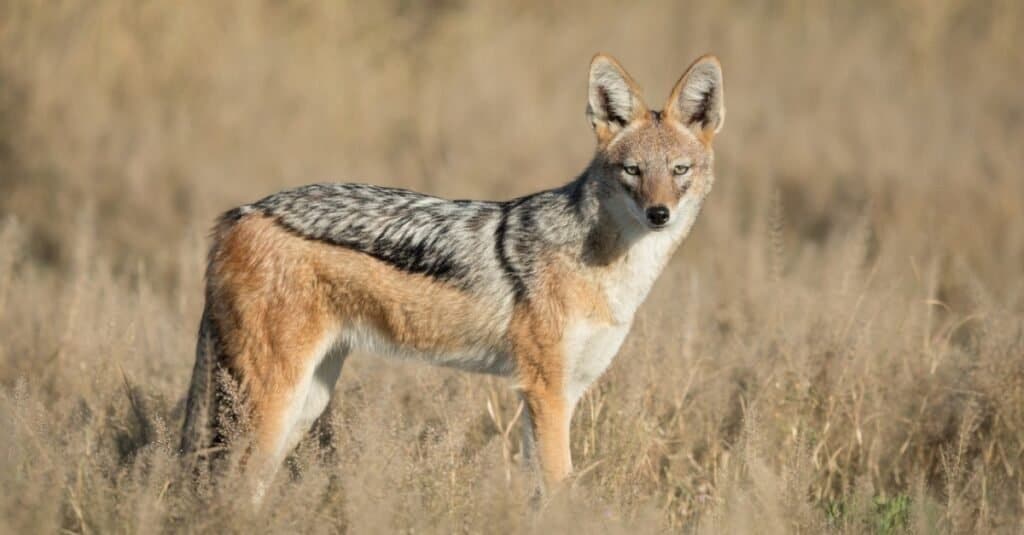
iStock.com/StuPorts
The jackal and coyote are both animals that rely on their teeth to land a fatal bite on their enemies. Jackals will bite and latch onto the back of their enemies and then shake them to death. Coyotes will chase down their foes, grab a vital area like the next, and drag them to the ground while cutting them to ribbons with their sharp claws.
The combat skills of both animals are somewhat similar, and they are both ambush predators and persistence hunters, depending on whether they are together in a pack or alone.
Who Would Win in a Fight Between a Jackal and a Coyote?
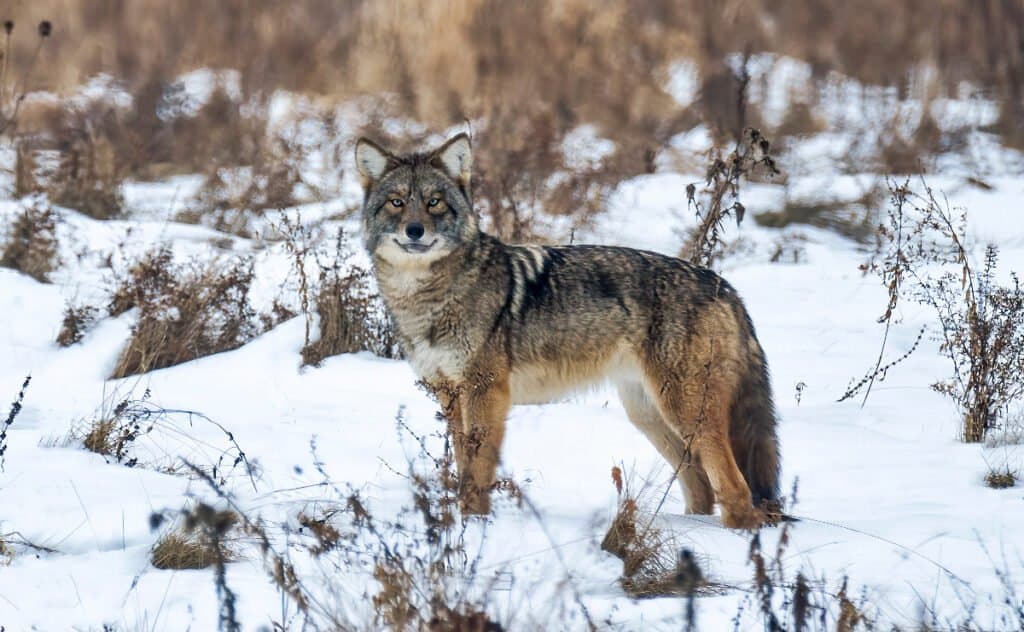
Fiona M. Donnelly/Shutterstock.com
A coyote would win a fight against a jackal. Coyotes have a few advantages in terms of their size and tooth length. Sure, their bite isn’t as powerful as a jackal, but their teeth are longer and better for tearing away flesh. Moreover, coyotes are much more aggressive in fights than jackals.
Jackals are quite skittish, and they have no problem scavenging. They can find a recent kill and take bites instead of killing all their own food. Coyotes have to hunt for their food, and they’re more experienced at fighting.
The two creatures would inevitably sense each other by smell long before they saw each other. When they clash, they would bite and claw until one of them lands a fatal blow. Given the coyote’s experience in fighting, longer teeth, and size advantage, it’s likely they will come away the winner.
More from A-Z Animals
.more-snake-card-image { max-height:140px !important; }
@media (min-width: 481px) {
.mobile-top-content {
display: none;
}
}
#mobileTopContentCTACarouselControls { overflow: hidden; text-overflow: ellipsis; white-space: nowrap; }
.mobile-top-content .more { color: #fff; }
.mobile-top-content a { color: #fff; text-decoration: underline; }
.mobile-top-content a:hover { color: #fff; text-decoration: underline; }
@media (max-width: 480px) {
.mobile-top-content {
background-color: #06a10b;
color: #fff;
text-align: center;
/*height: 60px;
padding-top:5px;*/
font-size:80%;
/* display: block; */
margin: 0px -30px;
}
}
Although they may look similar jackals and coyotes are actually two different animals, and they come from different parts of the world. Jackals primarily live in Africa and Asia. Coyotes live in parts of North America and Central America. What would happen if these two canine animals met and fought? We’re going to take a look at a hypothetical jackal vs coyote fight. Discover which of these diminutive dogs has what it takes to win this battle!
Comparing a Jackal and a Coyote

A-Z-Animals.com
| Jackal | Coyote | |
| Size | Weight: 11lbs – 26lbs Height: 16in Length: 24in – 30in |
Weight: 15lbs – 45lbs Height: 24in – 26in at the shoulder Length: 30in – 35in |
| Speed and Movement Type | 40 mph | 35-40 mph |
| Bite Power and Teeth | 94 Bite Force Quotient (BFQ) – 42 teeth – 1-inch, curved canines – They used their teeth to grab and then shake their prey. |
88 Bite Force Quotient (BFQ) 681 N bite power – 42 teeth 1.5-inch-long canines – Teeth used to grip and tear enemies. |
| Senses | – Better sense of smell than domestic dogs and wolves – Great sense of vision at night – Very acute hearing that helps them find prey in underground burrows |
– Great vision, including low-light and peripheral vision. – Sense of smell is similar to dogs – Good sense of hearing that allows them to hear up to a quarter of a mile |
| Defenses | – Speed – Their amazing senses |
– Speed – Senses help it avoid trouble |
| Offensive Capabilities | – Use their teeth to deliver a fatal bite to the back of the head and shake enemies | – Strong bite that helps them latch onto enemies and bring them to the ground. – May use sharp claws as a secondary form of offense |
| Predatory Behavior | – Can hunt or scavenge as part of a small group or alone – Opportunistic predator and persistence hunter – May eat carrion |
– Ambush predator when hunting alone – Hunt in packs for large prey using persistence predation |
What Are Key Differences Between a Jackal and a Coyote?

iStock.com/SteveByland
Jackals live in Africa and coyotes live in North America and Central America. Coyotes are larger than jackals, but they have a slightly weaker bite force. Coyotes have the scientific name Canis latrans and jackals are named Canis aureus.
Jackals will live alone, in pairs or packs. Coyotes are typically pack animals and they have a rigid social hierarchy. These are the most significant differences between these animals. Even though many of their features are similar, they are distinct animals.
The Key Factors in a Fight Between a Jackal and a Coyote

Derek R. Audette/Shutterstock.com
How are we going to say which of the two creatures is the most likely to succeed in a battle when they live half a world away? Determining the winner of the fight is going to require some guesswork based on hard evidence.
In this case, we’re going to look at key factors including physical features of the coyote and jackal along with how the two battle their foes. By doing this, we’ll gain enough insight to say which of them is stronger, faster, and deadlier in a fight!
Physical Features of a Jackal and a Coyote

iStock.com/GatorDawg
The easiest way to get a good idea of which animal has the better chance of winning is to look at their physical features. These characteristics will help us learn about which animal is strongest, fastest, and has the tools needed to kill the other. We’re going to examine five of these key factors to demonstrate whether the jackal or coyote is better prepared for a fight.
Jackal vs Coyote: Size
Both jackals and coyotes are related to dogs, and they tend to be a bit smaller than the largest breeds. A jackal weighs up to 26lbs on average and stands about 16in tall while having a length of about 2.5ft. Coyotes are bigger, weighing up to 45lbs, growing almost 3ft long, and standing up to 26in tall.
Coyotes have the size advantage.
Jackal vs Coyote: Speed and Movement
Both jackals and coyotes utilize their speed when capturing prey. Jackals can reach a top speed of 40 mph. Interestingly, the coyote can run between 35mph and 40mph, so they are just as fast as one another.
These two animals tie in terms of speed and movement.
Jackal vs Coyote: Bite Power and Teeth
These animals rely on their teeth to kill their prey. A jackal has 42 teeth that measure 1 inch in length. They’re good for grabbing hold of their prey and not letting go. Coyotes have similar teeth, but they’re 1.5 inches long.
The jackal’s bite for measures at 94 BFQ and a coyote’s bite for measures at 88 BFQ, so the jackal has a slightly more powerful bite than the coyote.
Coyotes have better teeth, but jackals bite just a little harder. This section is a tie.
Jackal vs Coyote: Senses
A jackal has senses that are refined to help them hunt. For example, jackals have a stronger sense of smell that is better than a dog’s sense of smell, they have great night vision, and their hearing is good enough to hear animals moving in burrows underground.
Coyotes also have great vision, especially at night. Their sense of smell is only about as good as a dog’s. Their hearing is good enough to hear creatures moving a quarter-mile away.
The jackal has better senses and gets the advantage.
Jackal vs Coyote: Physical Defenses
Both of these canines are known for being small, so they each rely on their speed to get away from trouble and their senses to inform them when trouble is coming.
Jackals and coyotes tie in terms of physical defenses.
Combat Skills of a Jackal and a Coyote

iStock.com/StuPorts
The jackal and coyote are both animals that rely on their teeth to land a fatal bite on their enemies. Jackals will bite and latch onto the back of their enemies and then shake them to death. Coyotes will chase down their foes, grab a vital area like the next, and drag them to the ground while cutting them to ribbons with their sharp claws.
The combat skills of both animals are somewhat similar, and they are both ambush predators and persistence hunters, depending on whether they are together in a pack or alone.
Who Would Win in a Fight Between a Jackal and a Coyote?

Fiona M. Donnelly/Shutterstock.com
A coyote would win a fight against a jackal. Coyotes have a few advantages in terms of their size and tooth length. Sure, their bite isn’t as powerful as a jackal, but their teeth are longer and better for tearing away flesh. Moreover, coyotes are much more aggressive in fights than jackals.
Jackals are quite skittish, and they have no problem scavenging. They can find a recent kill and take bites instead of killing all their own food. Coyotes have to hunt for their food, and they’re more experienced at fighting.
The two creatures would inevitably sense each other by smell long before they saw each other. When they clash, they would bite and claw until one of them lands a fatal blow. Given the coyote’s experience in fighting, longer teeth, and size advantage, it’s likely they will come away the winner.







